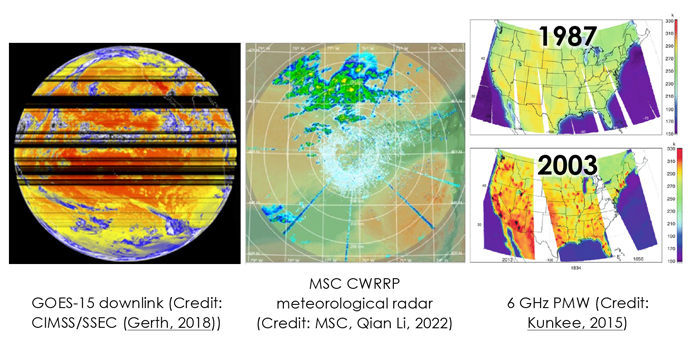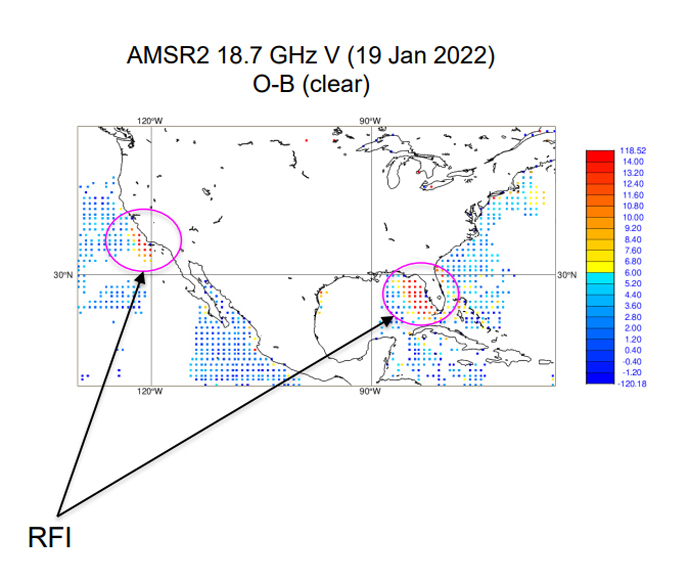
Stephen English, Head of Earth System Assimilation Section at ECMWF
In February 2022, 162 scientists from diverse communities (radio astronomy, meteorology, Earth remote sensing and spectrum management) came together at the RFI2022 workshop to discuss a growing issue of concern to all: Radio Frequency Interference (RFI). Radio frequency refers to that part of the electromagnetic spectrum between 30 Hz and 300 GHz and is referred to as radio spectrum (this is broader than the frequencies we think of as ‘radio’ in our day-to-day lives).
There are many uses of the radio spectrum to support critical services: for example, your mobile phone, military applications and, of course, weather forecasting. It is a challenge for governments to balance competing demands for radio spectrum. We all want faster and more reliable data on our mobile phones, but we also need the weather forecast to be accurate.
Spectrum is a finite, shared resource and decisions taken on allocations can have far reaching consequences, which can sometimes be serious for science applications. In meteorology, for example, observations of thermal infrared and microwave radiation provide a large amount of the information used by weather forecast and climate models. Other science applications, such as Earth remote sensing and radio astronomy, share similar challenges and concerns. All these science domains need clean spectrum because they are measuring very weak natural signals. By clean we mean free from any detectable man-made signals.
The RFI2022 workshop follows five previous RFI workshops, the first in 2001. They offer the opportunity for science users of spectrum to come together, share their experiences, talk about monitoring and possible mitigation strategies, as well as how best to influence the regulatory process.
Even the SETI (Search for Extra-Terrestrial Intelligence) community are involved because, as was reported at the workshop, most signals thought to be from “ET” end up being shown to be RFI from our own emissions!
Is 5G a threat?
Firstly, it is important to say 5G is not the only threat. There are many new users of spectrum. However, 5G needs a lot of spectrum so there is currently concern over its potential impact.
Yan Soldo showed results produced by Thibault Caillet (ANFR) for working groups of the ITU showing the impact of 5G RFI in C-band (a band that will be used for example by the Copernicus Imaging Microwave Radiometer (CIMR)) (see Figure 1). It is remarkable to see how the 5G impact, though dominant over land, spreads over 1000 km out to sea. This is not a land-only problem.

Figure 1: Impact of 5G at C-band presented by Yan Soldo (ESA) from work by Thibault Caillet. Credit: ANFR - French contribution to ITU - 5D/976 and 7C/306
The importance of spectrum to NWP
Passive microwave observations are vital for operational numerical weather prediction (NWP) centres (see for example in my talk as well as those of Harlow, Beaulne, Collard, Guedj, Murata, Tingwell, and Dahoui). Indeed, the speakers confirmed the observations between 20 and 200 GHz have the largest impact on the skill of NWP of any observation type.
Furthermore, we should always think of the microwave bands as a single system for meteorology, because of their interdependency of use. To consider individual bands in isolation may give a very misleading impression of their value. See talk by Renee Leduc (Narayan Strategy).
Also, in the past, it was widely assumed that (i) RFI was only a problem over land and (ii) satellite data were only important for NWP over the ocean. This workshop clearly showed that both statements are no longer true. There is growing use in NWP of protected bands over land, notably for 50-60 GHz, and RFI is being seen over the ocean, a trend expected to increase.
The loss of these microwave bands to operational meteorology would therefore be a disaster. This is of course recognised by regulatory authorities, but there is not always agreement on what level of RFI is considered “safe” for meteorological applications.
Are we already seeing RFI?
RFI is already being reported at lower frequencies (below 20 GHz). Low frequencies are mostly used to monitor the Earth’s surface but also precipitation (see Chris Kidd’s presentation). The concern is this could now extend to higher frequencies used to observe atmospheric temperature and humidity.
So far, no cases of RFI at higher frequency bands (e.g. 50-60 GHz, 183 GHz) have been seen, but as recent trends have been towards more interest in these bands for new applications, it is being watched carefully. Casey and Beaulne showed three key areas where RFI is already affecting operations:
- Downlink of satellite data (Figure 2, left) – the black horizontal lines show where data has been lost.
- Rainfall radar (Figure 2, centre) – areas of interference can be seen as radial lines.
- Passive microwave radiances (PMW) (Figure 2, right) - red and orange areas show measurements which are too hot to be natural showing how much the RFI increased at C-band between 1987 and 2003.

Figure 2: From presentation by Casey (Met Service Canada (MSC)) and Beaulne (Environment Canada) showing three different issues arising from RFI. CIMSS/SSEC = Cooperative Institute of Meteorological Satellite Studies/Space Science and Engineering; CWRRP = Canadian Weather Radar Replacement Project, PMW = passive microwave.
How is RFI being monitored?
The workshop was shown many efforts to monitor RFI across the different application areas. I called on Science Working Groups of the Coordination Group for Meteorological Satellites to coordinate international efforts to compare such monitoring, to further separate anomalies from real signal. However, there will always be the problem of what some speakers referred to as “insidious RFI”: RFI that is too small to detect with such methods, but large enough to be comparable to the normal size of corrections data assimilation makes to the model. Insidious RFI is easily misinterpreted as real signal, and there are no options for mitigation or even detection, making it difficult to report to regulatory authorities.
Numerical weather prediction itself can be a powerful tool to identify RFI, through techniques used to spot problems in satellite instruments. For example, Mohamed Dahoui showed how the difference between observed brightness temperature and values calculated from ECMWF’s model can identify lower levels of RFI than monitoring the observations alone, because the variation of the scene itself is removed (Figure 3).

Figure 3: Anomaly (RFI) detection using NWP observation minus background (O-B), as shown by Dahoui, clearly showing large differences due to RFI in the pink circled areas at 19 GHz (vertically polarized channel).
The workshop highlighted the success of using machine learning (ML), especially in radio astronomy, for anomaly detection, and ML may be able to further enhance RFI screening. Whilst this and NWP-based monitoring may be a good approach, neither solves the fundamental problem that the most dangerous RFI is RFI that looks like real meteorological signal in the data. Therefore, the policy to manage the situation through international regulation remains the right one.
Do we all speak the same language?
It was recognised that terminology differences between spectrum users, radio engineers and spectrum managers can cause barriers to understand different proposed safe limits and how to interpret them. Roger Oliva presented an initiative by the IEEE Standards Agency to introduce clear and well-documented standards for RFI reporting, which should make communication between groups more straightforward. This is good news.
Can’t we design observing systems that are RFI robust?
Ed Kim (NASA) noted that current generation satellite sensors have no RFI mitigation, because the problem was not widely recognised more than twenty years ago, when these systems were designed. Craig Donlon (ESA) and Steen Savstrup Kristensen (Technical University of Denmark) showed that a future mission, CIMR, will to some extent try to address RFI in its design, and some mitigation may be possible in ground processing. However, there is a limit to what technology and clever processing can do: international agreement, such as can be achieved at the World Radiocommunication Conference, a key event held every four years that updates the international Radio Regulations, remains the most effective way to ensure continued high-quality services.
Next steps
In summary, new and exciting initiatives to use the radio spectrum are starting, and weather scientists need to participate in the discussion. The science community takes the view that new users of spectrum are welcome, as long as discussions on how to meet the needs of all are carried out in a respectful and informed way. It is therefore vital that the science community interacts with and supports Spectrum Managers to give them the evidence they need in these discussions.
It was fantastic to learn from other communities (radio astronomy and Earth remote sensing) who are also addressing RFI problems; there is much meteorology can learn from these communities. A common theme concerned education about spectrum management; this includes learning about the role of ITU-R and increasing awareness of the Radio Regulations (especial footnotes). This is very important, to ensure users are empowered to understand the process of spectrum management/allocations, know who to report anomalies to and how to contribute to the debate.
RFI is a major issue that will affect the future of our science in a profound way, but the linking of arms and sharing of knowledge between the science communities is a very positive step forward.
Further information
The RFI 2022 workshop was held under the URSI in collaboration with ECMWF. It was a virtual event. See all the workshop presentations.
